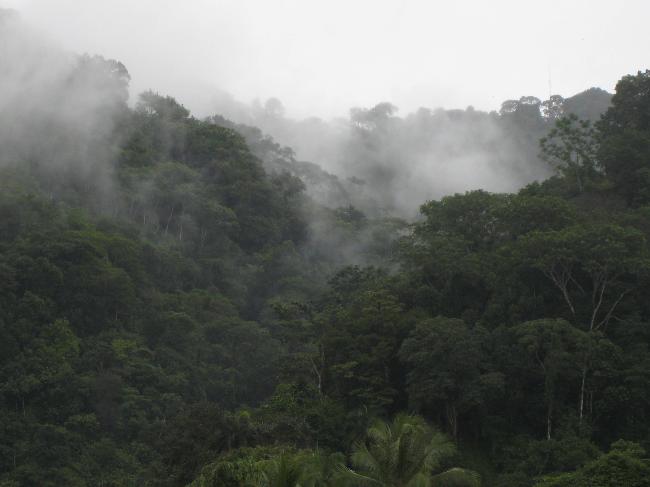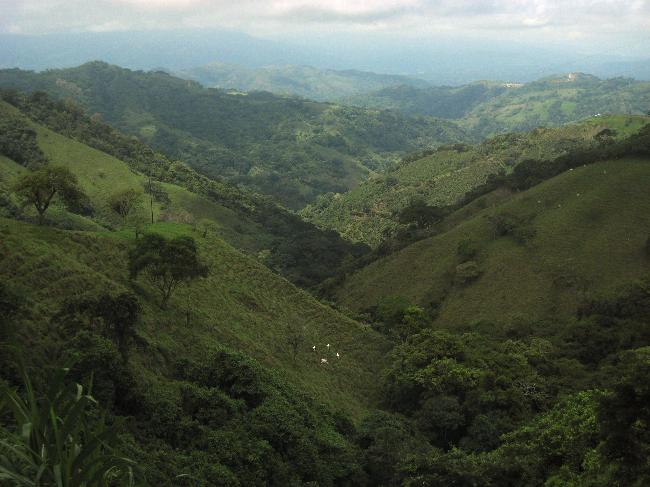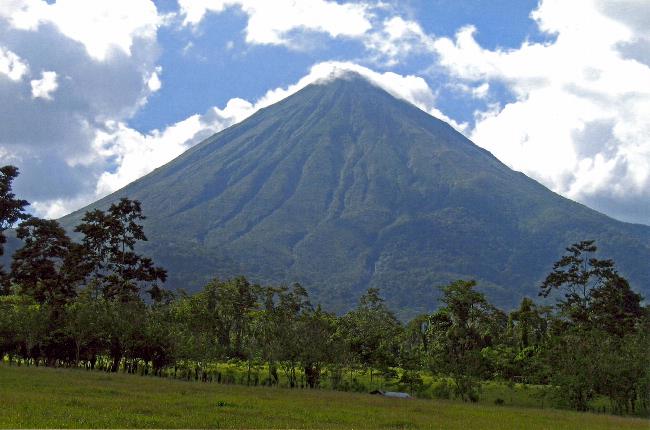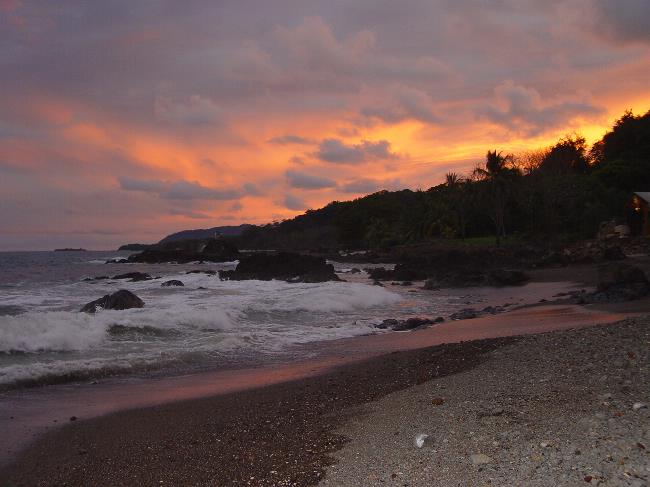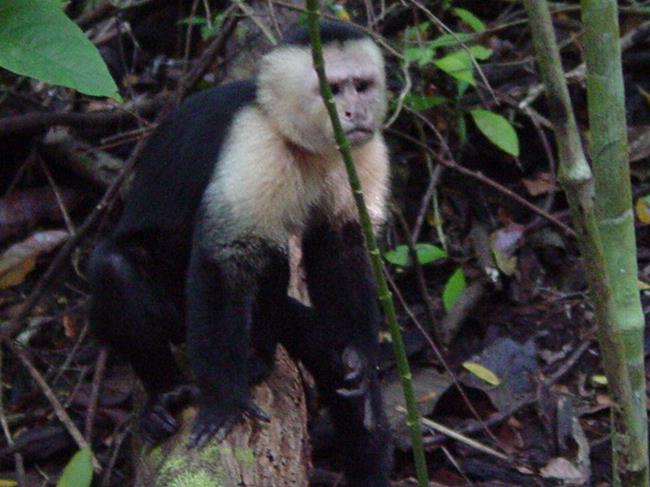Introduction :: COSTA RICA
-
Although explored by the Spanish early in the 16th century, initial attempts at colonizing Costa Rica proved unsuccessful due to a combination of factors, including disease from mosquito-infested swamps, brutal heat, resistance by natives, and pirate raids. It was not until 1563 that a permanent settlement of Cartago was established in the cooler, fertile central highlands. The area remained a colony for some two and a half centuries. In 1821, Costa Rica became one of several Central American provinces that jointly declared their independence from Spain. Two years later it joined the United Provinces of Central America, but this federation disintegrated in 1838, at which time Costa Rica proclaimed its sovereignty and independence. Since the late 19th century, only two brief periods of violence have marred the country's democratic development. In 1949, Costa Rica dissolved its armed forces. Although it still maintains a large agricultural sector, Costa Rica has expanded its economy to include strong technology and tourism industries. The standard of living is relatively high. Land ownership is widespread.
Geography :: COSTA RICA
-
Central America, bordering both the Caribbean Sea and the North Pacific Ocean, between Nicaragua and Panama
10 00 N, 84 00 W
Central America and the Caribbean
total: 51,100 sq km
land: 51,060 sq km
water: 40 sq km
note: includes Isla del Coco
country comparison to the world: 130
slightly smaller than West Virginia
total: 661 km
border countries (2): Nicaragua 313 km, Panama 348 km
1,290 km
territorial sea: 12 nm
exclusive economic zone: 200 nm
continental shelf: 200 nm
tropical and subtropical; dry season (December to April); rainy season (May to November); cooler in highlands
coastal plains separated by rugged mountains including over 100 volcanic cones, of which several are major active volcanoes
mean elevation: 746 m
elevation extremes: lowest point: Pacific Ocean 0 m
highest point: Cerro Chirripo 3,810 m
hydropower
agricultural land: 37.1%
arable land 4.9%; permanent crops 6.7%; permanent pasture 25.5%
forest: 51.5%
other: 11.4% (2011 est.)
1,015 sq km (2012)
roughly half of the nation's population resides in urban areas; the capital of San Jose is the largest city and home to approximately one-fifth of the population
occasional earthquakes, hurricanes along Atlantic coast; frequent flooding of lowlands at onset of rainy season and landslides; active volcanoes
volcanism: Arenal (elev. 1,670 m), which erupted in 2010, is the most active volcano in Costa Rica; a 1968 eruption destroyed the town of Tabacon; Irazu (elev. 3,432 m), situated just east of San Jose, has the potential to spew ash over the capital city as it did between 1963 and 1965; other historically active volcanoes include Miravalles, Poas, Rincon de la Vieja, and Turrialba
deforestation and land use change, largely a result of the clearing of land for cattle ranching and agriculture; soil erosion; coastal marine pollution; fisheries protection; solid waste management; air pollution
party to: Biodiversity, Climate Change, Climate Change-Kyoto Protocol, Desertification, Endangered Species, Environmental Modification, Hazardous Wastes, Law of the Sea, Marine Dumping, Ozone Layer Protection, Wetlands, Whaling
signed, but not ratified: Marine Life Conservation
four volcanoes, two of them active, rise near the capital of San Jose in the center of the country; one of the volcanoes, Irazu, erupted destructively in 1963-65
People and Society :: COSTA RICA
-
4,872,543 (July 2016 est.)
country comparison to the world: 124
noun: Costa Rican(s)
adjective: Costa Rican
white or mestizo 83.6%, mulato 6.7%, indigenous 2.4%, black of African descent 1.1%, other 1.1%, none 2.9%, unspecified 2.2% (2011 est.)
Spanish (official), English
Roman Catholic 76.3%, Evangelical 13.7%, Jehovah's Witness 1.3%, other Protestant 0.7%, other 4.8%, none 3.2%
Costa Rica's political stability, high standard of living, and well-developed social benefits system set it apart from its Central American neighbors. Through the government's sustained social spending - almost 20% of GDP annually - Costa Rica has made tremendous progress toward achieving its goal of providing universal access to education, healthcare, clean water, sanitation, and electricity. Since the 1970s, expansion of these services has led to a rapid decline in infant mortality, an increase in life expectancy at birth, and a sharp decrease in the birth rate. The average number of children born per women has fallen from about 7 in the 1960s to 3.5 in the early 1980s to below replacement level today. Costa Rica's poverty rate is lower than in most Latin American countries, but it has stalled at around 20% for almost two decades.
Costa Rica is a popular regional immigration destination because of its job opportunities and social programs. Almost 9% of the population is foreign-born, with Nicaraguans comprising nearly three-quarters of the foreign population. Many Nicaraguans who perform unskilled seasonal labor enter Costa Rica illegally or overstay their visas, which continues to be a source of tension. Less than 3% of Costa Rica's population lives abroad. The overwhelming majority of expatriates have settled in the United States after completing a university degree or in order to work in a highly skilled field.
0-14 years: 22.82% (male 568,738/female 543,312)
15-24 years: 16.75% (male 416,046/female 399,931)
25-54 years: 43.99% (male 1,078,000/female 1,065,327)
55-64 years: 8.9% (male 211,670/female 222,183)
65 years and over: 7.54% (male 169,646/female 197,690) (2016 est.)
population pyramid:

Central America and Caribbean
::COSTA RICA

Population Pyramid
A population pyramid illustrates the age and sex structure of a country's population and may provide insights about political and social stability, as well as economic development. The population is distributed along the horizontal axis, with males shown on the left and females on the right. The male and female populations are broken down into 5-year age groups represented as horizontal bars along the vertical axis, with the youngest age groups at the bottom and the oldest at the top. The shape of the population pyramid gradually evolves over time based on fertility, mortality, and international migration trends.
For additional information, please see the entry for Population pyramid on the Definitions and Notes page under the References tab.
total dependency ratio: 45.4%
youth dependency ratio: 32.4%
elderly dependency ratio: 12.9%
potential support ratio: 7.7% (2015 est.)
total: 30.9 years
male: 30.4 years
female: 31.3 years (2016 est.)
country comparison to the world: 108
1.19% (2016 est.)
country comparison to the world: 98
15.7 births/1,000 population (2016 est.)
country comparison to the world: 122
4.6 deaths/1,000 population (2016 est.)
country comparison to the world: 201
0.8 migrant(s)/1,000 population (2016 est.)
country comparison to the world: 62
roughly half of the nation's population resides in urban areas; the capital of San Jose is the largest city and home to approximately one-fifth of the population
urban population: 76.8% of total population (2015)
rate of urbanization: 2.74% annual rate of change (2010-15 est.)
SAN JOSE (capital) 1.17 million (2015)
at birth: 1.05 male(s)/female
0-14 years: 1.05 male(s)/female
15-24 years: 1.04 male(s)/female
25-54 years: 1.01 male(s)/female
55-64 years: 0.95 male(s)/female
65 years and over: 0.86 male(s)/female
total population: 1.01 male(s)/female (2016 est.)
25 deaths/100,000 live births (2015 est.)
country comparison to the world: 115
total: 8.3 deaths/1,000 live births
male: 9 deaths/1,000 live births
female: 7.4 deaths/1,000 live births (2016 est.)
country comparison to the world: 151
total population: 78.6 years
male: 75.9 years
female: 81.4 years (2016 est.)
country comparison to the world: 58
1.9 children born/woman (2016 est.)
country comparison to the world: 137
76.2% (2011)
9.3% of GDP (2014)
country comparison to the world: 23
1.11 physicians/1,000 population (2013)
1.2 beds/1,000 population (2012)
improved:
urban: 99.6% of population
rural: 91.9% of population
total: 97.8% of population
unimproved:
urban: 0.4% of population
rural: 8.1% of population
total: 2.2% of population (2015 est.)
improved:
urban: 95.2% of population
rural: 92.3% of population
total: 94.5% of population
unimproved:
urban: 4.8% of population
rural: 7.7% of population
total: 5.5% of population (2015 est.)
0.33% (2015 est.)
country comparison to the world: 89
10,000 (2015 est.)
country comparison to the world: 97
200 (2015 est.)
country comparison to the world: 103
degree of risk: intermediate
food or waterborne diseases: bacterial diarrhea
vectorborne diseases: dengue fever
note: active local transmission of Zika virus by Aedes species mosquitoes has been identified in this country (as of August 2016); it poses an important risk (a large number of cases possible) among US citizens if bitten by an infective mosquito; other less common ways to get Zika are through sex, via blood transfusion, or during pregnancy, in which the pregnant woman passes Zika virus to her fetus (2016)
24% (2014)
country comparison to the world: 73
1.1% (2009)
country comparison to the world: 130
7.6% of GDP (2015)
country comparison to the world: 34
definition: age 15 and over can read and write
total population: 97.8%
male: 97.7%
female: 97.8% (2015 est.)
total: 15 years
male: 15 years
female: 16 years (2014)
total number: 39,082
percentage: 5% (2002 est.)
total: 25%
male: 21.3%
female: 31.4% (2014 est.)
country comparison to the world: 62
Government :: COSTA RICA
-
conventional long form: Republic of Costa Rica
conventional short form: Costa Rica
local long form: Republica de Costa Rica
local short form: Costa Rica
etymology: the name means "rich coast" in Spanish and was first applied in the early colonial period of the 16th century
presidential republic
name: San Jose
geographic coordinates: 9 56 N, 84 05 W
time difference: UTC-6 (1 hour behind Washington, DC, during Standard Time)
7 provinces (provincias, singular - provincia); Alajuela, Cartago, Guanacaste, Heredia, Limon, Puntarenas, San Jose
15 September 1821 (from Spain)
Independence Day, 15 September (1821)
previous 1825; latest effective 8 November 1949; amended many times, last in 2015 (2016)
civil law system based on Spanish civil code; judicial review of legislative acts in the Supreme Court
accepts compulsory ICJ jurisdiction; accepts ICCt jurisdiction
citizenship by birth: yes
citizenship by descent: yes
dual citizenship recognized: yes
residency requirement for naturalization: 7 years
18 years of age; universal and compulsory
chief of state: President Luis Guillermo SOLIS Rivera (since 8 May 2014); First Vice President Helio FALLAS Venega (since 8 May 2014); Second Vice President Ana Helena CHACON Echeverria (since 8 May 2014); note - the president is both chief of state and head of government
head of government: President Luis Guillermo SOLIS Rivera (since 8 May 2014); First Vice President Helio FALLAS Venegas (since 8 May 2014); Second Vice President Ana Helena CHACON Echeverria (since 8 May 2014)
cabinet: Cabinet selected by the president
elections/appointments: president and vice presidents directly elected on the same ballot by modified majority popular vote (40% threshold) for a 4-year term (eligible for non-consecutive terms); election last held on 2 February 2014 with a runoff on 6 April 2014 (next to be held in February 2018)
election results: Luis Guillermo SOLIS Rivera elected president; percent of vote - Luis Guillermo SOLIS Rivera (PAC) 77.8%; Johnny ARAYA (PLN) 22.2%
description: unicameral Legislative Assembly or Asamblea Legislativa (57 seats; members directly elected in multi-seat constituencies - corresponding to the country's 7 provinces - by proportional representation vote; members serve 4-year terms)
elections: last held on 2 February 2014 (next to be held in February 2018)
election results: percent of vote by party - NA; seats by party - PLN 18, PAC 13, FA 9, PUSC 8, PML 4, other 5
highest court(s): Supreme Court of Justice (consists of 22 judges organized into 3 cassation chambers each with 5 judges, and the Constitutional Chamber with 7 judges)
judge selection and term of office: Supreme Court of Justice judges elected by the National Assembly for 8-year terms with renewal decided by the National Assembly
subordinate courts: appellate courts; trial courts; first instance and justice of the peace courts; Superior Electoral Tribunal
Accessibility Without Exclusion or PASE [Oscar Andres LOPEZ Arias]
Broad Front (Frente Amplio) or PFA [Ana Patricia MORA]
Citizen Action Party or PAC [Olivier PEREZ Gonzalez]
Costa Rican Renovation Party or PRC [Gerardo Justo OROZCO Alvarez]
Libertarian Movement Party or ML [Victor Danilo CUBERO Corrales]
National Integration Party or PIN [Walter MUNOZ Cespedes]
National Liberation Party or PLN [Bernal JIMENEZ]
National Restoration Party or PRN [Carlos AVENDANO]
Patriotic Alliance [Jorge ARAYA Westover]
Popular Vanguard [Humberto VARGAS]
Social Christian Unity Party or PUSC [Gerardo VARGAS]
Authentic Confederation of Democratic Workers or CATD (Communist Party affiliate)
Chamber of Coffee Growers
Confederated Union of Workers or CUT (Communist Party affiliate)
Confederation of Workers Rerum Novarum or CTRN (National Libertion Party affiliate)
Costa Rican Confederation of Democratic Workers or CCTD (National Libertion Party affiliate)
Costa Rican Exporter's Chamber or CADEXCO
Costa Rican Solidarity Movement
Costa Rican Union of Private Sector Enterprises or UCCAEP
Federation of Public Service Workers or FTSP
National Association for Economic Development or ANFE
National Association of Educators or ANDE
National Association of Public and Private Employees or ANEP
BCIE, CACM, CD, CELAC, FAO, G-77, IADB, IAEA, IBRD, ICAO, ICC (national committees), ICCt, ICRM, IDA, IFAD, IFC, IFRCS, ILO, IMF, IMO, IMSO, Interpol, IOC, IOM, IPU, ISO, ITSO, ITU, ITUC (NGOs), LAES, LAIA (observer), MIGA, NAM (observer), OAS, OIF (observer), OPANAL, OPCW, Pacific Alliance (observer), PCA, SICA, UN, UNCTAD, UNESCO, UNHCR, UNIDO, Union Latina, UNWTO, UPU, WCO, WFTU (NGOs), WHO, WIPO, WMO, WTO
chief of mission: Ambassador Roman MACAYA Hayes (since 18 September 2014)
chancery: 2114 S Street NW, Washington, DC 20008
telephone: [1] (202) 480-2200
FAX: [1] (202) 265-4795
consulate(s) general: Atlanta, Chicago, Houston, Los Angeles, Miami, New Orleans, New York, San Juan (Puerto Rico), Tampa (FL), Washington DC
consulate(s): San Francisco
chief of mission: Ambassador Stafford Fitzgerald HANEY (since 30 June 2015)
embassy: Calle 98 Via 104, Pavas, San Jose
mailing address: APO AA 34020
telephone: [506] 2519-2000
FAX: [506] 2519-2305
five horizontal bands of blue (top), white, red (double width), white, and blue, with the coat of arms in a white elliptical disk placed toward the hoist side of the red band; Costa Rica retained the earlier blue-white-blue flag of Central America until 1848 when, in response to revolutionary activity in Europe, it was decided to incorporate the French colors into the national flag and a central red stripe was added; today the blue color is said to stand for the sky, opportunity, and perseverance, white denotes peace, happiness, and wisdom, while red represents the blood shed for freedom, as well as the generosity and vibrancy of the people
note: somewhat resembles the flag of North Korea; similar to the flag of Thailand but with the blue and red colors reversed
yiguirro (clay-colored robin); national colors: blue, white, red
name: "Himno Nacional de Costa Rica" (National Anthem of Costa Rica)
lyrics/music: Jose Maria ZELEDON Brenes/Manuel Maria GUTIERREZ
note: adopted 1949; the anthem's music was originally written for an 1853 welcome ceremony for diplomatic missions from the US and UK; the lyrics were added in 1903
Economy :: COSTA RICA
-
Prior to the global economic crisis, Costa Rica enjoyed stable economic growth. The economy contracted in 2009 but resumed growth at about 4% per year in 2010-15. While traditional agricultural exports of bananas, coffee, sugar, and beef are still the backbone of commodity export trade, a variety of industrial and specialized agricultural products have broadened export trade in recent years. High value-added goods and services, including medical devices, have further bolstered exports. Tourism continues to bring in foreign exchange, as Costa Rica's impressive biodiversity makes it a key destination for ecotourism.
Foreign investors remain attracted by the country's political stability and relatively high education levels, as well as the incentives offered in the free-trade zones; Costa Rica has attracted one of the highest levels of foreign direct investment per capita in Latin America. The US-Central American-Dominican Republic Free Trade Agreement (CAFTA-DR) entered into force on 1 January 2009 after significant delays within the Costa Rican legislature. CAFTA-DR has increased foreign direct investment in key sectors of the economy, including the insurance and telecommunications sectors. However, poor infrastructure, high energy costs, bureaucracy, weak investor protection, and legal uncertainty due to the difficulty of enforcing contracts and overlapping and at times conflicting responsibilities between agencies, remain impediments to greater competitiveness.
Costa Rica’s economy also faces challenges due to a rising fiscal deficit, rising public debt, and relatively low levels of domestic revenue. Poverty has remained around 20-25% for nearly 20 years, and the strong social safety net that had been put into place by the government has eroded due to increased financial constraints on government expenditures. Unlike the rest of Central America, Costa Rica is not highly dependent on remittances, which in 2014 represented 1% of GDP. Immigration from Nicaragua has increasingly become a concern for the government. The estimated 300,000-500,000 Nicaraguans in Costa Rica, legally and illegally, are an important source of mostly unskilled labor, but also place heavy demands on the social welfare system.
$79.26 billion (2016 est.)
$76.02 billion (2015 est.)
$73.33 billion (2014 est.)
note: data are in 2016 dollars
country comparison to the world: 93
$57.69 billion (2015 est.)
4.3% (2016 est.)
3.7% (2015 est.)
3% (2014 est.)
country comparison to the world: 54
$16,100 (2016 est.)
$15,700 (2015 est.)
$15,300 (2014 est.)
note: data are in 2016 dollars
country comparison to the world: 102
14.3% of GDP (2016 est.)
15.1% of GDP (2015 est.)
14.9% of GDP (2014 est.)
country comparison to the world: 121
household consumption: 62.3%
government consumption: 16.9%
investment in fixed capital: 22.2%
investment in inventories: 0.5%
exports of goods and services: 29.6%
imports of goods and services: -31.5% (2016 est.)
agriculture: 5.5%
industry: 18.6%
services: 75.9% (2016 est.)
bananas, pineapples, coffee, melons, ornamental plants, sugar, corn, rice, beans, potatoes; beef, poultry, dairy; timber
medical equipment, food processing, textiles and clothing, construction materials, fertilizer, plastic products
4% (2016 est.)
country comparison to the world: 56
2.295 million
note: official estimate; excludes Nicaraguans living in Costa Rica (2016 est.)
country comparison to the world: 119
agriculture: 14%
industry: 22%
services: 64% (2006 est.)
9.3% (2016 est.)
9.4% (2015 est.)
country comparison to the world: 107
24.8% (2011 est.)
lowest 10%: 1.2%
highest 10%: 39.5% (2009 est.)
50.3 (2009)
45.9 (1997)
country comparison to the world: 19
revenues: $8.115 billion
expenditures: $11.31 billion (2016 est.)
14.1% of GDP (2016 est.)
country comparison to the world: 195
-5.5% of GDP (2016 est.)
country comparison to the world: 169
62.3% of GDP (2016 est.)
60.2% of GDP (2015 est.)
country comparison to the world: 60
calendar year
0.3% (2016 est.)
0.8% (2015 est.)
country comparison to the world: 42
21.5% (31 December 2010)
23% (31 December 2009)
country comparison to the world: 3
14.5% (31 December 2016 est.)
14.24% (31 December 2015 est.)
country comparison to the world: 45
$5.946 billion (31 December 2016 est.)
$5.273 billion (31 December 2015 est.)
country comparison to the world: 94
$21.55 billion (31 December 2015 est.)
$18 billion (31 December 2014 est.)
country comparison to the world: 89
$35.8 billion (31 December 2016 est.)
$30.53 billion (31 December 2015 est.)
country comparison to the world: 72
$2.015 billion (31 December 2012 est.)
$1.443 billion (31 December 2011 est.)
$1.445 billion (31 December 2010 est.)
country comparison to the world: 100
-$2.57 billion (2016 est.)
-$2.093 billion (2015 est.)
country comparison to the world: 154
$9.824 billion (2016 est.)
$9.503 billion (2015 est.)
country comparison to the world: 89
bananas, pineapples, coffee, melons, ornamental plants, sugar; beef; seafood; electronic components, medical equipment
US 33.6%, China 6.2%, Mexico 4.6%, Nicaragua 4.3%, Netherlands 4.2%, Guatemala 4% (2015)
$14.76 billion (2016 est.)
$14.38 billion (2015 est.)
country comparison to the world: 83
raw materials, consumer goods, capital equipment, petroleum, construction materials
US 45.3%, China 9.8%, Mexico 7.1% (2015)
$7.96 billion (31 December 2016 est.)
$7.834 billion (31 December 2015 est.)
country comparison to the world: 80
$24.91 billion (31 December 2016 est.)
$23.18 billion (31 December 2015 est.)
country comparison to the world: 83
$31.86 billion (31 December 2016 est.)
$28.75 billion (31 December 2015 est.)
country comparison to the world: 68
$3.354 billion (31 December 2016 est.)
$3.154 billion (31 December 2015 est.)
country comparison to the world: 76
Costa Rican colones (CRC) per US dollar -
543.4 (2016 est.)
534.57 (2015 est.)
534.57 (2014 est.)
538.32 (2013 est.)
502.9 (2012 est.)
Energy :: COSTA RICA
-
10 billion kWh (2014 est.)
country comparison to the world: 100
9.2 billion kWh (2014 est.)
country comparison to the world: 98
600 million kWh (2014 est.)
country comparison to the world: 66
800 million kWh (2014 est.)
country comparison to the world: 74
2.9 million kW (2014 est.)
country comparison to the world: 98
30.7% of total installed capacity (2012 est.)
country comparison to the world: 180
0% of total installed capacity (2012 est.)
country comparison to the world: 176
55.9% of total installed capacity (2012 est.)
country comparison to the world: 40
13.3% of total installed capacity (2012 est.)
country comparison to the world: 25
0 bbl/day (2015 est.)
country comparison to the world: 120
1,300 bbl/day (2013 est.)
country comparison to the world: 78
0 bbl/day (2013 est.)
country comparison to the world: 188
0 bbl (1 January 2016 es)
country comparison to the world: 199
0 bbl/day (2013 est.)
country comparison to the world: 198
53,000 bbl/day (2014 est.)
country comparison to the world: 103
0 bbl/day (2013 est.)
country comparison to the world: 201
51,300 bbl/day (2013 est.)
country comparison to the world: 80
0 cu m (2013 est.)
country comparison to the world: 197
0 cu m (2013 est.)
country comparison to the world: 133
0 cu m (2013 est.)
country comparison to the world: 186
0 cu m (2013 est.)
country comparison to the world: 128
0 cu m (1 January 2014 es)
country comparison to the world: 193
7.2 million Mt (2013 est.)
country comparison to the world: 117
Communications :: COSTA RICA
-
total subscriptions: 859,514
subscriptions per 100 inhabitants: 18 (July 2015 est.)
country comparison to the world: 82
total: 7.536 million
subscriptions per 100 inhabitants: 157 (July 2015 est.)
country comparison to the world: 104
general assessment: good domestic telephone service in terms of breadth of coverage
domestic: point-to-point and point-to-multi-point microwave, fiber-optic, and coaxial cable link rural areas; Internet service is available
international: country code - 506; landing points for the Americas Region Caribbean Ring System (ARCOS-1), MAYA-1, and the Pan American Crossing submarine cables that provide links to South and Central America, parts of the Caribbean, and the US; connected to Central Am (2015)
multiple privately owned TV stations and 1 publicly owned TV station; cable network services are widely available; more than 100 privately owned radio stations and a public radio network (2007)
.cr
total: 2.877 million
percent of population: 59.8% (July 2015 est.)
country comparison to the world: 92
Transportation :: COSTA RICA
-
number of registered air carriers: 1
inventory of registered aircraft operated by air carriers: 39
annual passenger traffic on registered air carriers: 1,617,075
annual freight traffic on registered air carriers: 9,284,160 mt-km (2015)
TI (2016)
161 (2013)
country comparison to the world: 35
total: 47
2,438 to 3,047 m: 2
1,524 to 2,437 m: 2
914 to 1,523 m: 27
under 914 m: 16 (2013)
total: 114
914 to 1,523 m: 18
under 914 m: 96 (2013)
refined products 662 km (2013)
total: 278 km
narrow gauge: 278 km 1.067-m gauge
note: the entire rail network fell into disrepair and out of use at the end of the 20th century; since 2005, certain sections of rail have been rehabilitated (2014)
country comparison to the world: 124
total: 39,018 km
paved: 10,133 km
unpaved: 28,885 km (2010)
country comparison to the world: 90
730 km (seasonally navigable by small craft) (2011)
country comparison to the world: 74
total: 1
by type: passenger/cargo 1 (2010)
country comparison to the world: 149
major seaport(s): Atlantic Ocean (Caribbean) - Puerto Limon; Pacific Ocean - Caldera
Military and Security :: COSTA RICA
-
no regular military forces; Ministry of Public Security, Government, and Police (2011)
Transnational Issues :: COSTA RICA
-
Costa Rica and Nicaragua regularly file border dispute cases over the delimitations of the San Juan River and the northern tip of Calero Island to the International Court of Justice (ICJ); in 2009, the ICJ ruled that Costa Rican vessels carrying out police activities could not use the river, but official Costa Rican vessels providing essential services to riverside inhabitants and Costa Rican tourists could travel freely on the river; in 2011, the ICJ provisionally ruled that both countries must remove personnel from the disputed area; in 2013, the ICJ rejected Nicaragua's 2012 suit to halt Costa Rica's construction of a highway paralleling the river on the grounds of irreparable environmental damage; in 2013, the ICJ, regarding the disputed territory, ordered that Nicaragua should refrain from dredging or canal construction and refill and repair damage caused by trenches connecting the river to the Caribbean and upheld its 2010 ruling that Nicaragua must remove all personnel; in early 2014, Costa Rica brought Nicaragua to the ICJ over offshore oil concessions in the disputed region
stateless persons: 1,806 (2015)
current situation: Costa Rica is a source, transit, and destination country for men, women, and children subjected to sex trafficking and forced labor; Costa Rican women and children, as well as those from Nicaragua, the Dominican Republic, and other Latin American countries, are sex trafficked in Costa Rica; child sex tourism is a particular problem with offenders coming from the US and Europe; men and children from Central America, including indigenous Panamanians, and Asia are exploited in agriculture, construction, fishing, and commerce; Nicaraguans transit Costa Rica to reach Panama, where some are subjected to forced labor or sex trafficking
tier rating: Tier 2 Watch List – Costa Rica does not fully comply with the minimum standards for the elimination of trafficking; however, it is making significant efforts to do so; anti-trafficking law enforcement efforts declined in 2014, with fewer prosecutions and no convictions and no actions taken against complicit government personnel; some officials conflated trafficking with smuggling, and authorities reported the diversion of funds to combat smuggling hindered anti-trafficking efforts; the government identified more victims than the previous year but did not make progress in ensuring that victims received adequate protective services; specialized services were limited and mostly provided by NGOs without government support, even from a dedicated fund for anti-trafficking efforts; victims services were virtually non-existent outside of the capital (2015)
transshipment country for cocaine and heroin from South America; illicit production of cannabis in remote areas; domestic cocaine consumption, particularly crack cocaine, is rising; significant consumption of amphetamines; seizures of smuggled cash in Costa Rica and at the main border crossing to enter Costa Rica from Nicaragua have risen in recent years (2008)










